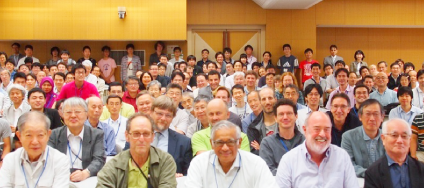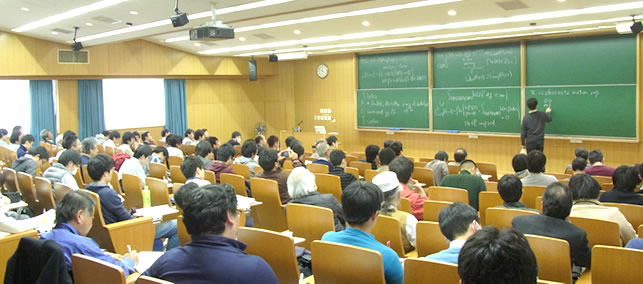2018年11月、数理解析研究所は「国際共同利用・共同研究拠点」に認定されました。
論文への謝辞記載に関するお願いについて
共同研究開催期間中の保育室設置について
希望者には情報を提供可能です。詳しくは研究代表者か共同利用掛にお問い合わせください。
訪問滞在型研究リスト
2025年度
数理最適化分野の理論とアルゴリズムに関する研究を推進し,国内の研究コミュニティのさらなる発展に寄与するために,ワークショップ・研究集会の開催を企画する.その際,関連する分野で世界的に活躍する研究者を招待する.
数理最適化(数理計画)問題は,与えられた制約条件の下で目的を最大化・最小化する問題であり,自然科学,工学,経済学,情報科学などの様々な分野で頻繁に現れる.数理最適化問題に対して,最適解の構造や性質を解明すること,および最適解もしくは良質な解を高速に計算するアルゴリズムを構築することが重要な研究テーマである.とくに,近年は実務上の要請により,半正定値制約,二次錐制約や混合整数制約など,より複雑な制約条件をもち,かつ巨大データにより表現される大規模な最適化問題を解く必要性が増している.そのため,最適化問題の背後に潜む数理構造を理解するために新たな理論体系を構築し,その理論に基づき高性能なアルゴリズムを設計することが必要とされている.
本研究計画では,数理最適化における理論とアルゴリズムの研究をさらに推進・発展させることを目的として,数理最適化に関する国際ワークショップや研究集会を企画する.日本の研究グループが世界をリードする下記の分野をさらに強化すべく,ワークショップでは,これらの分野に関する講演を中心に据える.
・ 離散最適化:離散凸解析理論,アルゴリズム的グラフマイナー理論
・ 連続最適化:錐最適化の理論とアルゴリズム
・ 数理最適化の機械学習との融合ならびに実務への応用
また,これらのワークショップ開催時に,当該分野で世界的に活躍する研究者を招待し,情報交換を行うとともに研究交流を促進する.そのうちの 2~3 名を指導的研究者として招聘し, RIMS に数ヶ月滞在してもらい,日本の研究者との共同研究を通じて数理最適化研究の発展へとつなげる.
-
7th Conference on Discrete Optimization and Machine Learning (訪問滞在型研究計画)【RIMS共同研究(公開型)】
部屋:420号室 期間:2025-05-12〜2025-05-16
代表者:塩浦 昭義(東京科学大学工学院経営工学系)/DEZA Antoine(McMaster University,Department of Computing & Software) -
部屋:東京科学大学 期間:2025-05-26〜2025-05-29
代表者:塩浦 昭義(東京科学大学工学院経営工学系) -
CONTO-Cones: Theory and optimization (訪問滞在型研究計画)【RIMS共同研究(公開型)】
部屋:420号室 期間:2025-12-1〜2025-12-03
代表者:塩浦 昭義(東京科学大学工学院経営工学系)/ブルノ・フィゲラ・ロウレンソ(統計数理研究所)
2026年度
Higher structures have emerged as a new eld in mathematics, as well as in mathematical and theoretical physics. Covering many di erent topics, this eld encompasses the following areas: moduli spaces, defor mation theory, derived geometry, enumerative geometry, representation theory, homotopy algebras, Poisson geometry and quantization, mirror symmetry, string theory, and quantum eld theory.
Higher structures refer to the structures introduced into various elds of mathematics by treating the objects of study as objects in higher categories. In many elds, this point of view has led to the discovery of hidden structures, often yielding deep new insights into the research area. Over the years, homotopy theory has developed powerful tools for dealing with higher categories, and as a result, the study of higher structures often involves introducing techniques from homotopy theory into other elds of mathematics.
In deformation theory, this means replacing Lie algebras with L or homotopy Lie algebras. In algebraic geometry, the ring of holomorphic functions on a variety is replaced by a di erential graded algebra. In representation theory, representations on vector spaces are replaced by representations on categories. In enumerative geometry, counting invariants (which answer questions such as how many twisted cubic curves lie on a Calabi-Yau threefold? ) are replaced by the dimensions of certain vector spaces (such as Gopakumar Vafa invariants). Quantum eld theories are de ned as functors from higher cobordism categories to higher linear categories, to name just a few examples.
Even though they are investigating similar fundamental questions and adopting the same general higher structural perspective, di erent communities have mostly worked independently of each other. Indeed, the techniques developed by the di erent schools are quite distinct. These topics are extremely active and are related to many areas of mathematics and physics. One objective of this project is to bring together the various higher structure communities active in di erent areas and originating from diverse backgrounds such as algebraic geometers, di erential geometers, and mathematical physicists to encourage more interaction and cross-fertilization between the elds, as well as identify new emerging directions. The project will bring together leading experts and young researchers in these subjects to promote interaction and collaboration.
To this purpose, we plan to include a week-long school, where a series of mini-courses will be delivered by world-renowned leading experts, aiming to facilitate communication between the elds. We will also have workshops presenting recent research. In addition, we plan to run a weekly seminar during April-June 2026. Furthermore, there will be a number of informal series of lectures and mini-courses on related topics. In particular, the project will focus on lectures in these areas:
・ Higher structures in Moduli spaces and Enumerative Geometry
・ Homotopy algebras, deformation theory, and quantization
・ DG manifolds in geometry and physics
RIMS Symposium I (WS1)
Theme: School on Moduli Spaces in Various Flavors of Geometry , April 13-17, 2026
Organizers: Kai Behrend, Hsuan-Yi Liao, Kaoru Ono, Mathieu Stienon, Ping Xu
Mini-course speakers
・ Alexey Bondal
・ Barbara Fantechi
・ Kenji Fukaya
・ Bernhard Keller *
・ Hiraku Nakajima
(*) to be con rmed
RIMS Symposium II (WS2)
Theme: Workshop on Moduli Spaces in Various Flavors of Geometry , April 20-24, 2026
Organizers: Kai Behrend, Hsuan-Yi Liao, Kaoru Ono, Mathieu Stienon, Ping Xu
RIMS Symposium III (WS3)
Theme: Workshop on DG Manifolds in Geometry and Physics , March 8-12, 2027
Organizers: Hsuan-Yi Liao, Kaoru Ono, Mathieu Stienon, Ping Xu
2026年度
The RIMS research project 2026 "The Mathematical Roads to QFT" will bring together worldwide leading mathematicians interested in the mathematical aspects of Quantum Field Theory, and their wide-ranging applications from high-energy physics to quantum simulation. It will take place at RIMS from April to July, 2026. The organizing committee is composed by C. Brennecke (IAM Bonn), S. Cenatiempo (GSSI L'Aquila), M. Falconi (Politecnico di Milano), F. Hiroshima (Kyushu University) and H. Ochiai (Kyushu University).
This project aims at stimulating scientific interactions between the different mathematical approaches to QFT, that range from probability theory and stochastic PDEs to operator theory and operator algebras, as well as statistical mechanics and microlocal analysis. The goal is to further advance our knowledge of QFT and its applications, with the ultimate goal of tackling the outstanding open problems in QFT such as the rigorous renormalization of physical theories, spontaneous symmetry breaking and critical phenomena.
The RIMS will host international guests both for the whole duration of the research project and for shorter visits. To foster an active and engaging participation of both experienced and young researchers, and stimulate interactions with the local community, some key events will be organized throughout the project, including an opening workshop in the second half of April, and a conference at the end of June. These events will offer a possibility, especially to young researchers, both to come in contact with the recent groundbreaking ideas, and to showcase and discuss the most recent advances in the field.
It is the commitment and hope of the organizing committee for this project to be successful in being a building block of new and exciting developments in the mathematics of quantum field theory.
Research Institute for Mathematical Sciences (RIMS)




